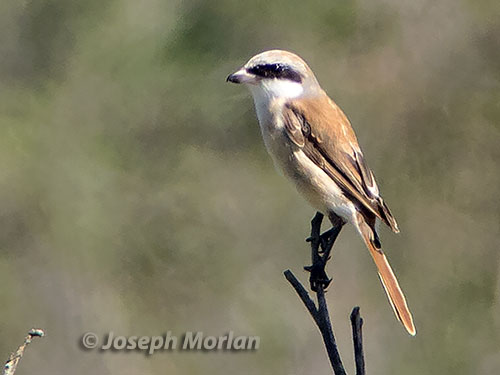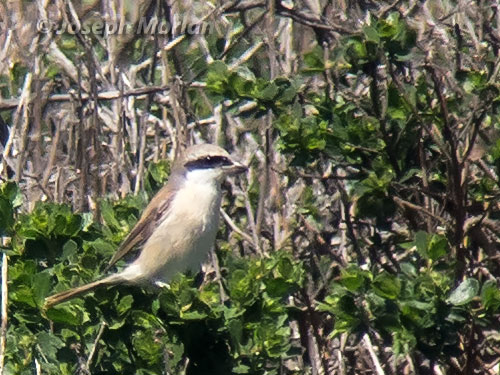Alder Creek Mouth, Manchester, Mendocino County, CA
19 March 2015
Joseph Morlan
 Photos © 19 March 2015 by Joseph Morlan. All rights reserved. Click here for higher resolution images.
Photos © 19 March 2015 by Joseph Morlan. All rights reserved. Click here for higher resolution images.Red-backed Shrike X Red-tailed Shrike (Lanius collurio
X L. phoenicuroides) hybrid.
Alder Creek Mouth, Manchester, Mendocino County, CA
19 March 2015
Joseph Morlan
 Photos © 19 March 2015 by Joseph Morlan. All rights reserved. Click here for higher resolution images.
Photos © 19 March 2015 by Joseph Morlan. All rights reserved. Click here for higher resolution images.
This bird was first seen and photographed by Alison Cebula on 5 March and reported regularly thereafter. This morning, Dan Singer, Robbie Fischer and I arrived at the mouth of Alder Creek and spent well over an hour searching the area before Dan Singer spotted the shrike about 12:30 p.m. on the brush-covered hillside across the creek, just northwest of the overlook at the end of the closed Alder Creek Road. Here the bird spent much time in the open perched in direct sunlight. Several other birders were already there and Jeff Anderson and Bonnie Bompart arrived shortly after Dan found the bird. We attempted to photograph the bird, but the distance and the shrike's relatively small size made photography a challenge. Jeff Anderson obtained some interesting video using an iPhone adapter attached to his spotting scope. Eventually we decided to get closer to the bird by taking the trail down toward the beach to the fishing access near the creek mouth. Here we were much closer to the bird. We noticed the shrike was singing and were able watch and hear the soft song. At one point the shrike flew across the river to our side and perched in the open at even closer range where these digiscoped photos were taken. The bird disappeared in the bushes for a while and then flew back to the hillside across the creek. We spent about 50 minutes studying this bird.
Description
The following description is based on memory and on photos:
A small shrike colored with a rich brown on its back and tail. The top of its head and its nape formed a grayish hood, blending into the brown upper back. A suffusion of rich brown was evident on the top and back of its crown extending to its nape. A broad, solid black mask extended from the bill across its face including its dark eyes and ending at its nape. This mask contrasted with its white throat and upper chest. Its underparts were white with a brownish buff wash on its sides and flanks extending faintly across the middle of its breast. Its bill was short and stubby appearing pinkish at its base with a black tip when
seen in good light. The wings were dark, but the rich brown coloration of the mantle extended across the wing panel, contrasting slightly with darker areas on its exposed primary coverts, alula and tertials. Photos appear to show secondary coverts largely missing on both wings. Legs and feet appeared dark.
This shrike sat upright most of the time and we could see its throat feathers moving as it sang a faint whisper song consisting of rather high unstructured notes reminiscent of the song of House Finch, punctuated by a series of louder, sharper notes. While singing, the shrike twitched its tail from side to side.
Identification
This is a fairly distinctive species but can be confused with immature plumages of the Northern Shrike (L. excubitor) from which it differs by its much smaller size and lack of any white patches in its wings. Its bill is also much shorter. This bird was reportedly misidentified as a Northern Shrike until photos were analyzed by Jon Dunn and Peter Pyle. In Eurasia, the Brown Shrike may be confused with several other potential look-alikes.
Isabelline Shrike (L. isabellinus) of Central Asia typically has a much grayer, more olive back contrasting more with the tail. It also has broader tail feathers with less rounded tips and a paler creamy yellowish buff wash on its underparts. It frequently exhibits a small white wing spot at the base of its primaries which is usually absent, but not unknown in Brown Shrike.
Although originally identified as a Brown Shrike (L. cristatus) several experts have expressed their belief that it is likely a Red-backed Shrike (L. collurio) X Isabelline Shrike hybrid. While recent photos of this bird are similar to some examples of that highly variable hybrid combination, I am not persuaded that such an unlikely hybrid between two species never before recorded in North America is responsible for this bird's appearance. Brown Shrike is known to hybridize occasionally (apparently only 2 known specimens, only one of which can be located) with Red-backed Shrike in central Asia and the two have been considered conspecific by some authors.
Tiger Shrike (L. tigrinus) of East Asia has obvious dark barring across its mantle usually extending across its sides and flanks. Its underparts are otherwise white, lacking the buffy wash of Brown Shrike.
Adult Bull-headed Shrike (L. bucephalus) also of East Asia has a grayish mantle, dark tail and usually shows a white patch at the base of its primaries. Juveniles have a reddish-brown back like Brown Shrike but have their underparts heavily barred.
Discussion
California has four previously accepted records of Brown Shrike as follows:
20-22 September 1984 at Southeast Farallon Island, SF
28 November 1986 - 26 April 1987 at Olema, MRN
24-25 September 2009 at Southeast Farallon Island, SF
21 November 2010 - 18 May 2011 at Clam Beach, McKinleyville, HUM
This individual seems to be a male. Female Brown and Red-backed Shrikes usually retain some dark barring on their sides and flanks, even as adults. Females also usually have a less defined facial mask. Adult male Brown Shrikes have an all dark bill while our bird has a pale base to the bill. This suggests that our bird is second calendar year (SY).
Four subspecies of Brown Shrike are currently recognized. Vagrants to North America have been assigned to the highly migratory nominate subspecies, L. c. cristatus. It typically has the crown reddish-brown lacking gray tones. The race L. c. superciliosus sometimes split as "Japanese Shrike" is brighter red-brown including its crown and it has a wider more distinct eyebrow and forehead than our bird. The southernmost race L. c. lucionensis, is the only race of Brown Shrike to invariably exhibit a gray crown and nape. Its mantle is also slightly duller in color than other races. A fourth subspecies L. c. confusus breeding in Manchuria and Amurland and migrating to southeast Asia is doubtfully distinct from nominate. It is said to be slightly paler, grayer and have a broader white forehead. It has also been interpreted to be an intergrade between L. c. lucionensis and nominate L. c. cristatus.
Another explanation is that our bird could be a hybrid with Red-backed Shrike, a species which typically has a gray hood, but apparently only two such specimens are known (Harris & Franklin 2000, Kryukov 1995, Lefranc 1997). Photos of Kryukov's specimen are here. Hartert's also reported a specimen of this hybrid combination in his collection, but the specimen cannot be located, and it was never described. McCarthy (2006) incorrectly attributed Lanius dichrourus Menzbir 1894. OD, not L. dichourus which appears to be a typographical error introduced by McCarthy to this hybrid combination. However L. dichrourus was sysnonimized with Lanius phoenicuroides raddei, a supposed race of the Red-tailed Shrike by Sushkin (1905). Sushkin's designation was bluntly criticized by Hartert (1906) who considered both forms to be synonyms of Lanius bogdanowi which is now considered a hybrid between Red-backed and Isabelline Shrikes (Ash & Atkins 2009). The type description by Menzbir is of a bird with a dull back, similar to L. lucionensis, but with a tail like that of Red-backed. It does not appear to be a good match for our bird.
Photos of the McKinleyville bird show a band of grayish blending across the back of the neck, not unlike our
bird. One possiblity is that the rusty areas on the crown and upper nape are retained immature plumage and that
the bird is simply a young L. c. lucionensis. I have also reviewed photos (slides) of the Olema Brown Shrike
taken in late March 1987. It clearly shows very dark central rectrices, not unlike the new feathers growing in
in recent photos of this individual. The top photo shows a stub of a new dark tail-feather growing in. Recent (27
March 2015) photos
by J. Sterling show these feathers more than half way grown and they are blackish with white outer webs. More
recent photos such as those taken by Monte Taylor here
clearly show the new feathers as dark brown at the base and lacking obvious white at the bases. It is now universally
acknowledged that the Mendocino bird is not a Red-backed Shrike. While some authorities who originally were reasonably
confident that the bird was a Red-backed Shrike have now backed down to a position of Red-backed X Isabelline Shrike;
I am not persuaded by their argument. Brian Small and Eugeny Panov have provided photos (in litt.) of L.
c. lucionensis which seem to be a reasonable match for our bird.
Addendum
Further research by Peter Pyle et a. (in press) have argued persuasively that this bird is likely a Red-backed
Shrike X Red-tailed Shrike (Lanius collurio X L. phoenicuroides) hybrid. Some photos show white on the inner
web of the base of newly grown r3 eliminating any plumage of Brown Shrike. As the bird is clearly not a pure Red-backed
Shrike, a hybrid hypothesis seems to be reasonable.
Text last edited 29 July 2015.
References
Ash J. and Atkins J. 2009. Birds of Ethiopia and Eritrea: An Atlas of Distribution. Helm.
Dean, A.R. 1982. Field characters of Isabelline and Brown Shrikes. Brit. Birds 75: 395-406 [PDF]
Harris. T. and Franklin K. 2000. Shrikes and Bush-shrikes: Including Wood-shrikes, Helmet-shrikes, Shrike Flycatchers, Philentomas, Batises and Wattle-eyes. Helm.
Hartert E. 1906. Miscellanea Ornithologica Part III. Novitates Zoologicae: A Journal of Zoology, 13:386-405. [PDF]
Kryukov A.P. 1995. Systematics of small Palearctic Shrikes of the "Cristatus group." In: Proceedings Western Foundation Vertebrate Zoology. 6:22-25. [PDF]
Kryukov A.P. and Gureev S.P. 1997. New data on interactions of Red-backed and Brown Shrikes (Lanius collurio and L. cristatus, Aves) in the zone of sympatry. Russian J. Zoology, 1:537-544 (Translated to English) [PDF]
Lefranc, N and Worfolk, T. 1997. Shrikes: a guide to the shrikes of the world.. Yale U.P. [Preview]
McCarthy, E.M. 2006. Handbook of Avian Hybrids of the World. Oxford U.P. [Preview]
Moores, N. 2004. Brown Shrike Lanius cristatus appearance and variability of individuals seen on migration in South Korea. [BirdsKorea web article]
Panov, E. 2011. The True Shrikes (Laniidae) of the World. Pensoft.
Sushkin, P. 1906. Notes on the birds of the Tarbagatai Range and Zaisson-noor Valley with descriptions of new forms. Bull. Brit. Orn. Club 16:56-61 [PDF]
Worfolk, T. 2000. Identification of Red-backed, Isabelline and Brown Shrikes. Dutch Birding 2000. 22: 323-362. [PDF]